Neuro: Attention and Working Memory
1/42
There's no tags or description
Looks like no tags are added yet.
Name | Mastery | Learn | Test | Matching | Spaced |
|---|
No study sessions yet.
43 Terms
Attention
How we actively process specific information present in out environment
Alertness
Current level of sensitivity or responsiveness to environmental cues (zeitgebers)
Norepinephrine Neurons
Originate in the locus coeruleus (LC) and plays a key role in alertness. Sends widespread projections (to brainstem, spinal cord, thalamus, cortex) that release norepinephrine from axon terminals.
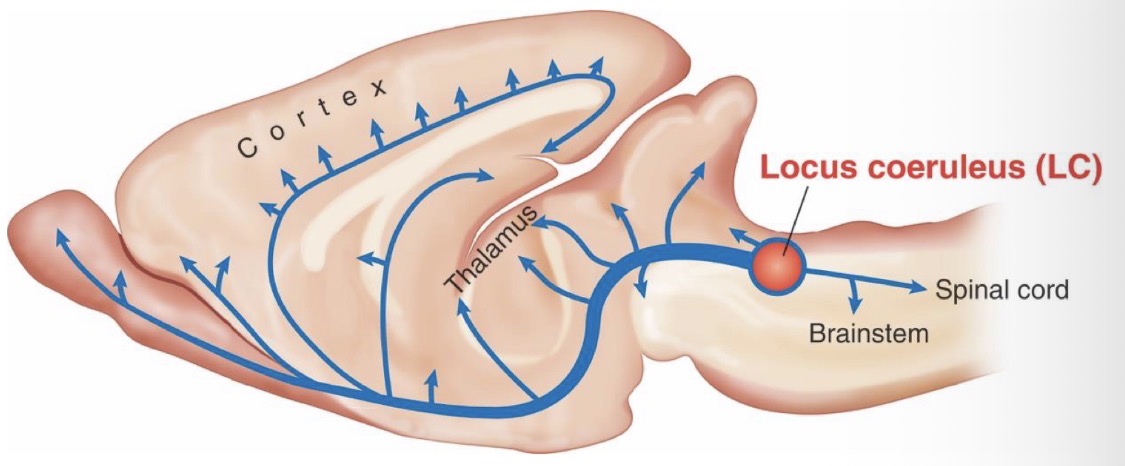
What happens when arousing stimuli activate the locus coeruleus (LC)?
Many brain areas are alerted at once
What does norepinephrine increase the response of?
Response of neurons to environment stimuli. When the LC releases more norepinephrine, the somatosensory neuron responds strongly to paw touch. It increases neuronal response as soon as paw is touched and reduced background activity increasing the signal to noise and detection of stimuli.
Low levels of norepinephrine
smaller somatosensory response
High levels of norepinephrine
Higher level of response
Selective attention/inattentional blindness
Keep track of one thing at the expense at not seeing the background. “select information from a clustered world”
Change blindness
As scenes change if you’re not looking at the particular part changing, you don’t see it
Human information processing is?
Parallel, up to a point and then serial (subquential)
Salient Stimuli
Draw out attention (pop out). Bottom-up attention or stimulus-driven. It is an item that pops out from other items due to its distinctive color
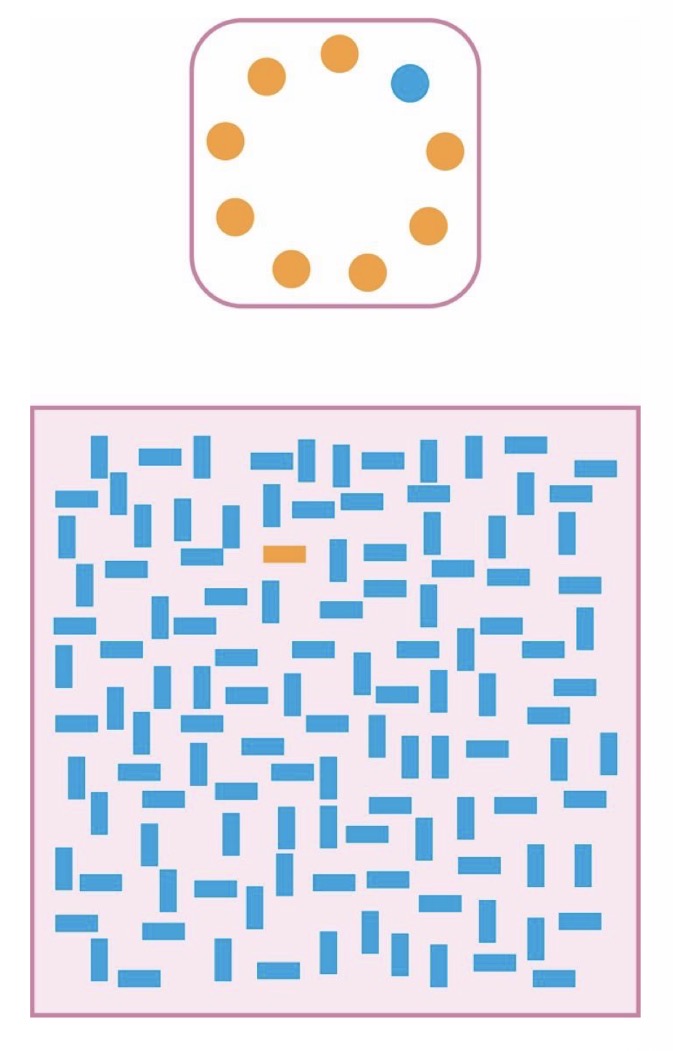
Serial Stimuli
Goal-directed or top-down attention. Goal-directed attention searches item-by-item serially to find goal object. Target does not pop out from background
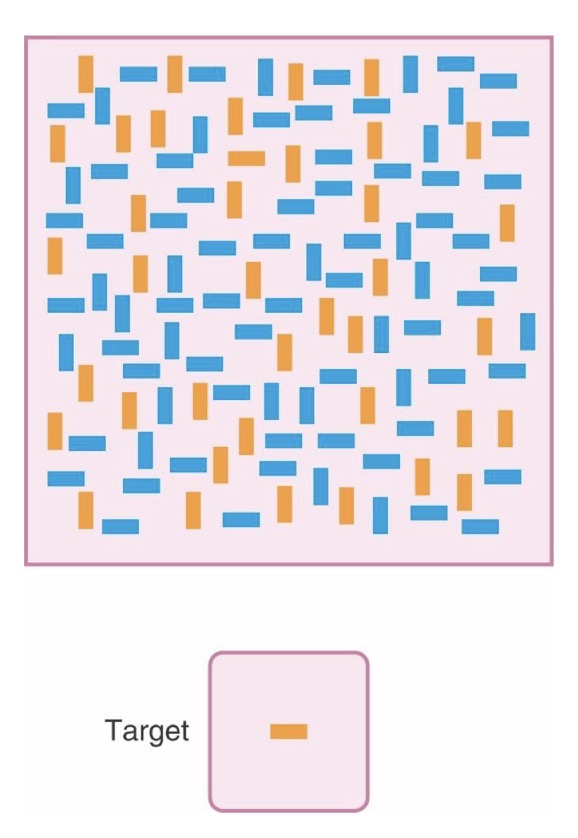
Feature-integration Theory
Visual search is easy (“pop out”) when it involves only a single feature – no attention is required
Conjunction search
Integrate across features represented in the brain requires directed, top down attention.
Serial Search
Assumes that items are examined one at a time. Search terminates when the target is found OR all items have been examined.
Stimulus Driven
Parallel search because the target has a distinct feature not present in distractors.
Stimulus Driven vs Serial Search
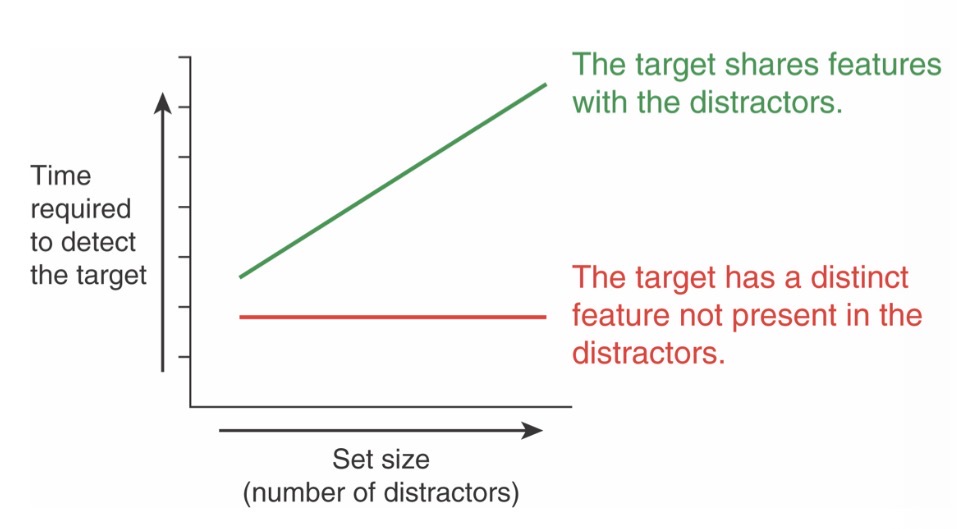
Stimulus-driven Visual Attention
activates the temporoparietal junction (TPJ) and ventral frontal cortex (VFC).
Goal-directed Visual Attention
visual information is processed by a network that includes dorsolateral prefrontal cortex (dlPFC), the intraparietal sulcus (IPS) and frontal eye fields (FEF).
What regions are involved when we selectively attend?
Prefrontal and parietal regions. More lateralized to the right hemisphere.
Contralateral Neglect
Failure to acknowledge objects in the field contralateral to the lesion and may not shave, apply makeup or dress left side of body. Damage to prefrontal and parietal regions.
Extinction (milder case of neglect)
May detect a single stimulus presented to contralateral (opposite side of what we paying attention to) visual field, BUT fail to detect the same stimulus when another stimulus is simultaneously presented to ipsilateral visual field.
What can frontal and parietal damage lead to?
Attentional neglect. Visuospatial neglect ignore objects toward the side of space contralateral to their brain lesion. (ex. drawings of patients with damage to the right hemisphere often demonstrate a failure to attend to stimuli in the left visual field).
Neglect associated with what lesions?
Posterior parietal cortex (inferior parietal lobe (IPL) or temporal parietal junction (TPJ)).
NOTE: damage to prefrontal and subcortical regions like the thalamus and basal ganglia can contribute to neglect.
Visual Neglect Syndrome (hemineglect)
Can be objects-based. When patients draw they look at the image and draw it from memory.
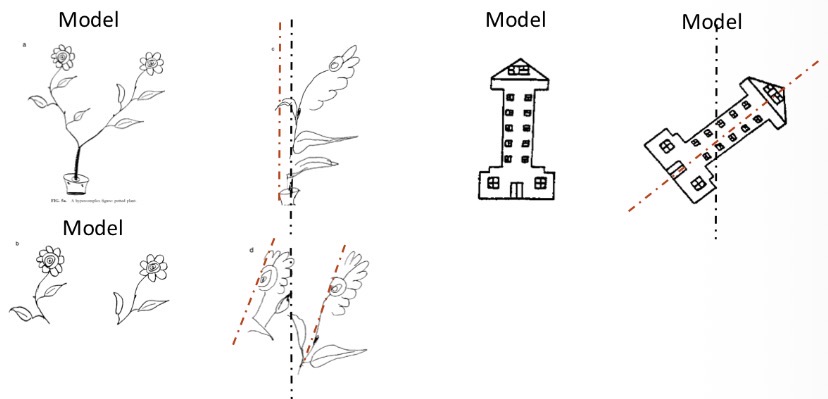
What happens when we rotate the image for patients with visual neglect syndrome when they can’t see the object?
They still won’t see it. (ex. dog can’t see half of the food in left side of bowl and we rotate the bowl so the food is in the right side. dog still can’t see it and continues to neglect it)
Hemineglect people also have?
Around 10% also have anosognosia (lack of awareness that they have it)
What is needed to inhibit attention to distractors? aka Attentional Control.
Frontal Lobe “executive control” and ability to ignore less relevant stimuli while focusing on relevant ones.
Example of Attentional Control: Cocktail Effect
While chatting with someone in a noisy, crowded room you hear your name mentioned in another conversation and almost effortless redirect your attention to that conversation.
Stoop Task
Saying color and not reading the color word. Compatible condition: word corresponds with ink color
Incompatible condition: word conflicts with ink color
What is activated during attentional conflict between two competing sources of information and its resolution?
Anterior cingulate and dorsolateral prefrontal cortex
Symptoms of ADHD
motor hyperactivity
inattention
impulsiveness
When are symptoms of ADHD most pronounced?
When the environment does not provide much sensory stimulation. (ex. hyperactivity in ADHD is often absent while children are watching a video that interests them)
What are effects of stimulants?
Inhibits reuptake of dopamine by blocking dopamine transporter (DAP). Enchances activity of neurotransmitter systems. Reduces symptoms of ADHD.
Working Memory
Is the ability to maintain and manipulate information over short periods of time. (ex. Calculating a tip, N-Back Task, List Sorting Task)
What is the frontoparietal circuitry implicated in?
Working memory capacity and development
Dorsolateral Prefrontal Cortex (DLPFC) and Posterior parietal cortex (frontoparietal network)
Correlates with working memory task
What connection is associated with sustained activity during maintenance and resistance?
Recurrent Connections
What neurons are activated during the delay period of a task?
Prefrontal cortical neurons and they make the recurrent connections that hold information in working memory.
What does DLPFC show?
sustained activity during the delay period
Difference between development of DLPFC function in nonhuman primates?
Increase in delay-related persistence DLPFC neuronal fitting in adults
What happens when we remember an item?
We activate the same brain regions as a when we view the item
What happens when we switch attentional focus from memory of face to memory of place?
We activate the same prefrontal and parietal areas as when we shift and focus attention to external stimuli